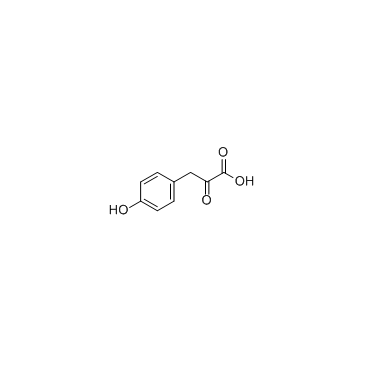4-Hydroxyphenylpyruvic acid

4-Hydroxyphenylpyruvic acid structure
|
Common Name | 4-Hydroxyphenylpyruvic acid | ||
|---|---|---|---|---|
| CAS Number | 156-39-8 | Molecular Weight | 180.15700 | |
| Density | 1.397 g/cm3 | Boiling Point | 380.8ºC at 760 mmHg | |
| Molecular Formula | C9H8O4 | Melting Point | 219-220 °C (dec.)(lit.) | |
| MSDS | Chinese USA | Flash Point | 198.3ºC | |
| Symbol |

GHS07 |
Signal Word | Warning | |
|
Structural variation governs substrate specificity for organic anion transporter (OAT) homologs. Potential remote sensing by OAT family members.
J. Biol. Chem. 282 , 23841-53, (2007) Organic anion transporters (OATs, SLC22) interact with a remarkably diverse array of endogenous and exogenous organic anions. However, little is known about the structural features that determine their substrate selectivity. We examined the substrate binding ... |
|
|
Mechanistic insights into Mg2+-independent prenylation by CloQ from classical molecular mechanics and hybrid quantum mechanics/molecular mechanics molecular dynamics simulations.
Biochemistry 53(30) , 5034-41, (2014) Understanding the mechanism of prenyltransferases is important to the design of engineered proteins capable of synthesizing derivatives of naturally occurring therapeutic agents. CloQ is a Mg(2+)-independent aromatic prenyltransferase (APTase) that transfers ... |
|
|
Elucidation of common pharmacophores from analysis of targeted metabolites transported by the multispecific drug transporter—Organic anion transporter1 (Oat1)
Bioorg. Med. Chem. 19 , 3320-40, (2011) Organic anion transporter 1 (Oat1), first identified as NKT, is a multispecific transporter responsible for the handling of drugs and toxins in the kidney and choroid plexus, but its normal physiological role appears to be in small molecule metabolite regulat... |
|
|
Allosteric inhibition of macrophage migration inhibitory factor revealed by ibudilast.
Proc. Natl. Acad. Sci. U. S. A. 107(25) , 11313-8, (2010) AV411 (ibudilast; 3-isobutyryl-2-isopropylpyrazolo-[1,5-a]pyridine) is an antiinflammatory drug that was initially developed for the treatment of bronchial asthma but which also has been used for cerebrovascular and ocular indications. It is a nonselective in... |
|
|
Production of 4-hydroxyphenyllactic acid by Lactobacillus sp. SK007 fermentation.
J. Biosci. Bioeng. 109(4) , 369-71, (2010) The production of 4-hydroxyphenyllactic acid (4-HO-PLA), a novel antifungal compound, was studied in Lactobacillus sp. SK007 growth. When grown in MRS broth, the strain could produce 75 microg/ml HO-4-PLA, which was the highest reported so far. Tyrosine and 4... |
|
|
Tyrosine-derived 4-hydroxyphenylpyruvate reacts with ketone test fields of 3 commercially available urine dipsticks.
Vet. Clin. Pathol. 39(3) , 354-7, (2010) The enzyme 4-hydroxyphenylpyruvate dioxygenase (HPPD) is key in tyrosine catabolism. Inhibition of HPPD results in tyrosinemia and increased urinary excretion of 3 phenylketones: 4-hydroxyphenylpyruvate (HPPA), 4-hydroxyphenyllactate (HPLA), and 4-hydroxyphen... |
|
|
Plantar keratoderma: a manifestation of tyrosinemia type II (Richner-Hanhart syndrome).
Ann. Saudi Med. 25(5) , 422-4, (2005)
|
|
|
Clinical, biochemical, and genetic analysis of a Korean neonate with hereditary tyrosinemia type 1.
Clin. Chem. Lab Med. 47(8) , 930-3, (2009) Hereditary tyrosinemia type 1 (HT1; MIM 276700) is caused by mutations in the fumarylaceto-acetate hydrolase (FAH) gene, and is the most severe disorder associated with the tyrosine catabolic pathway. HT1 is a very rare disorder and no genetically confirmed c... |
|
|
Effects of ethyl pyruvate and other α-keto carboxylic acid derivatives in a rat model of multivisceral ischemia and reperfusion.
J. Surg. Res. 165(1) , 151-7, (2011) Ethyl pyruvate (EP) has been shown to ameliorate hepatic, renal, and intestinal mucosal injury and down-regulate expression of several pro-inflammatory mediators in a wide variety of preclinical models of critical illnesses, such as sepsis, burn injury, acute... |
|
|
(4-Hydroxyphenyl)pyruvate dioxygenase from Streptomyces avermitilis: the basis for ordered substrate addition.
Biochemistry 42(7) , 2072-80, (2003) (4-hydroxyphenyl)pyruvate dioxygenase (HPPD) catalyzes the second step in the pathway for the catabolism of tyrosine, the conversion of (4-hydroxyphenyl)pyruvate (HPP) to homogentisate (HG). This reaction involves decarboxylation, substituent migration, and a... |